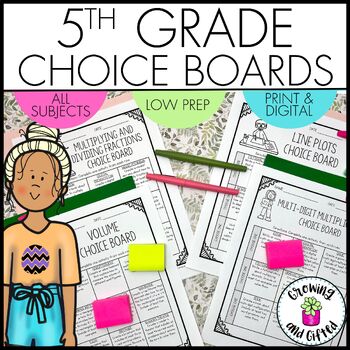5th Grade Choice Boards for Differentiation - Science, ELA, Math, Social Studies
- Zip
- Google Apps™
- Easel Activity

What educators are saying
Products in this Bundle (5)
Description
Fifth grade teachers searching for engaging science, math, social studies, and ELA activities, look no further! This bundle includes 15 math choice boards, 15 science choice boards, 15 social studies choice boards, and 15 reading and writing choice boards. Choice boards are excellent for differentiating your instruction for ALL students, including intervention and enrichment students! These choice boards are perfect for reviewing and extending what you've taught in class. Printable and digital versions are both included, and it's ready to be used!
What Topics are Covered on the 15 Math Choice Boards?
- 2-D Figures
- Coordinate Planes
- Decimals
- Equivalent Fractions
- Line Plots
- Measurement
- Money
- Multi-Digit Division
- Multi-Digit Multiplication
- Multiplying and Dividing Fractions
- Numerical Expressions
- Numerical Patterns
- Place Value
- Time
- Volume
What Topics are Covered on the 15 Science Choice Boards?
- Atoms and Molecules
- Chemical Changes in Matter
- Earth's Spheres
- Earth's Water
- Energy from the Sun
- Gravity
- Matter
- Physical Changes in Matter
- Plant and Animal Cells
- Plants
- Producers, Consumers, and Decomposers
- Properties of Matter
- Reducing Human Impact on Earth
- Shadows and Stars
- The Sun and Stars
What Topics are Covered on the 15 ELA Choice Boards?
- Author's Purpose
- Cause and Effect
- Compare and Contrast
- Figurative Language
- Main Idea
- Making Connections
- Making Inferences
- Making Predictions
- Poetry
- Point of View
- Sequencing
- Similes and Metaphors
- Story Elements
- Text Features
- Theme
What Topics are Covered on the 15 Social Studies Choice Boards?
- American Leaders
- American Revolution: Key Events
- American Revolution: Notable People
- Ancient American Civilizations
- Citizenship
- Colonial America
- European Exploration
- Founding Documents
- Government
- Maps
- Native Americans
- Primary and Secondary Sources
- U.S. Geography
- War of 1812
- Westward Expansion
What Is Included in This Resource?
- Teaching Tips
- Choice Board Folder Covers
- Student Pages for Each Choice Board Activity
- Posters with Directions for Each Choice Board Activity
- 60 Choice Boards - Specific to 5th Grade
- Rubric for Grading
- Self-Assessment
- Digital Version on Google Slides™ (Editable & Non-Editable Options)
- Easel Activity is Ready to Use!
- BONUS: Back to School Choice Board
On each choice board, students choose one activity from each row. They can work independently or collaboratively on the activities. These are differentiated for multiple learning styles, including auditory, visual, and kinesthetic.
How Can You Use Choice Boards?
- Assessment (a rubric is provided)
- Centers / Rotations / Stations
- Distance Learning / Digital Learning
- Early Finisher Work
- Enrichment for Gifted & High-Achieving Students
- Extension
- Morning Work / Seat Work / Bell Work
- Whole Class
Why Should You Use Choice Boards?
- Students love choice boards because they can choose which activities they’d like to complete.
- If you have gifted or high-level students, choice boards are excellent to use for extension and enrichment.
- I recommend having students choose one activity from the first row, one from the second row, and one from the third row to be sure a variety of topics are covered.
- My choice boards include activities for a variety of learning styles.
- Typically, the first column is for auditory learners, the second column is for visual learners, and the third column is for kinesthetic learners.
- It’s fun to see what types of activities your students choose because it will help you understand what their preferred learning styles are!
Where Can You Find More Information about Using Choice Boards?
- Click here for a free teacher's guide about using choice boards in your classroom.
- Click here if you’d like to download my free choice board posters.
- These posters can be printed and displayed in your classroom or shared with your students digitally, so students can refer to the directions about the different activities.
- Click here to visit my blog, where I provide tips for using choice boards in elementary classrooms.
Please Note:
You need to have a Google™ account to access this resource. Please contact me if you have any questions or concerns.
___________________________________________________________________
Resources You May Also Like:
Reading Comprehension & Writing Activities
___________________________________________________________________
✔ Be sure to leave feedback, so you can receive TPT credits to use on future purchases!
✔ Click here to follow my store and be the first to know about my new products, freebies, and sales!
✔ Click here to check out my blog, where I give teaching tips and information about free resources!





